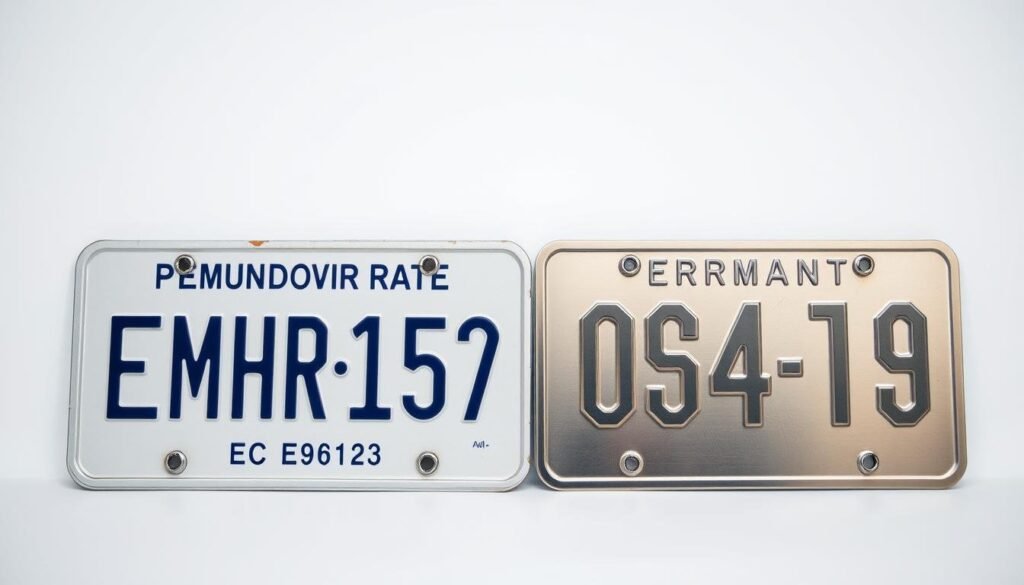Temporary vs. Permanent License Plates: When you buy a car, getting the right license plates is key. In the U.S., you might get temporary or permanent license plates. This depends on your state’s rules and your car’s registration status.
It’s important to know the difference between these two types of plates. Temporary plates are for new cars or when you’re changing ownership. They’re a temporary solution until you get your permanent plates.
Understanding when you’ll get temporary versus permanent plates is vital. It affects your driving experience.
Contents
- 1 Understanding License Plates in the United States
- 2 Temporary License Plates Explained
- 3 Permanent License Plates Explained
- 4 What’s the Difference Between a Temporary and Permanent License Plate
- 5 Practical Considerations for Vehicle Owners
- 6 Conclusion: Temporary vs. Permanent License Plates
- 7 FAQ
- 7.1 What is the main difference between a temporary and permanent license plate?
- 7.2 How long are temporary license plates valid?
- 7.3 Can I drive my vehicle without a license plate?
- 7.4 How do I obtain a permanent license plate?
- 7.5 Are there different types of permanent license plates?
- 7.6 Can I transfer my license plate to a new vehicle?
Understanding License Plates in the United States
In the United States, each state’s Department of Motor Vehicles (DMV) issues license plates. These plates are key for identifying vehicles. As a vehicle owner, you must follow your state’slicense plate lawsand rules.
State-specific Regulations
Different states have their own rules for license plates. For example, some states need a front and rear plate, while others just require a rear plate. The table below shows some of these differences.
| State | License Plate Requirement | Renewal Frequency |
|---|---|---|
| California | Rear plate only | Every 5 years |
| New York | Front and rear plates | Every 5 years |
| Texas | Rear plate only | Every 6 years |
Knowing these rules is key forvehicle ownership. You must make sure your vehicle is registered right. Also, follow your state’s DMV rules to avoid fines.
Temporary License Plates Explained
Understanding temporary license plates is key for car owners. They let you legally drive a new car until you get permanent plates. This is especially true when you buy a car and can’t drive it right away.
DMVs issue these plates. They are meant to be temporary. They let you drive legally until you get your permanent plates.
Issuance and Display
Getting a temporary license plate varies by state. Here’s what usually happens:
- You buy a car from a dealer or private seller.
- The seller or dealer gives the DMV the needed documents.
- The DMV then gives you a temporary plate, often made of paper.
- You must put this plate on your car as your state says.
It’s important to display your temporary plate right. Most states say it should be in the rear window or license plate bracket. Always follow your state’sDMV regulations for displaying it.
Here are some things to remember about temporary plates:
- They are only good for a short time, like 30 to 90 days.
- If your permanent plates don’t come, you might need to renew or replace your temporary one.
- Make sure to register your vehicle as your state requires to avoid fines.
In summary, temporary license plates are a big part of getting your car registered. Knowing how they work and how to use them helps you drive legally. This follows your state’s DMV rules.
Permanent License Plates Explained
Permanent license plates are made to last longer than temporary ones. They are built with stronger materials. Knowing about permanent license plates is key for following license plate laws.
After you register your vehicle, you get a permanent license plate. These plates show your vehicle’s number, where they were made, and when they expire. Each state has its own style for these plates.
To get a permanent license plate, you need to register your vehicle. You also have to pay fees. You must show proof of owning the vehicle, insurance, and who you are.
| Registration Requirement | Description | Notes |
|---|---|---|
| Proof of Ownership | Title or bill of sale | Must be valid and current |
| Proof of Insurance | Insurance policy documents | Must meet state minimum requirements |
| Identity Verification | Driver’s license or ID card | Must be valid and not expired |
You need to renew your permanent license plates every year or two. You’ll get a notice telling you how to renew. This keeps your vehicle’s registration current.
Staying on top of your registration is important. It keeps your vehicle legal and avoids fines. By understanding permanent license plates, you follow license plate laws and enjoy owning your vehicle without trouble.
What’s the Difference Between a Temporary and Permanent License Plate
Knowing the difference between temporary and permanent license plates is key for car owners. The main difference is how long they last and their purpose.
Temporary plates are for short use, like when you buy a car or wait for your permanent plates. They last from 30 to 90 days, based on your state’s rules.

Permanent plates, however, last as long as your car is registered. They’re made to last longer and are meant to stay on your car for a long time.
Choosing the Right Option
Choosing between temporary and permanent plates depends on several things. You should think about your state’s DMV rules, how long you need the plate, and what you prefer.
| Feature | Temporary License Plate | Permanent License Plate |
|---|---|---|
| Duration | Short-term (30-90 days) | Long-term (varies by state) |
| Purpose | Awaiting permanent plates or initial registration | Standard registration |
| Material | Often paper or lightweight material | Durable metal or plastic |
Understanding these differences helps you choose the right plate for you. It’s all about your specific needs.
Remember, license plate rules can vary by state. Always check with your local DMV for the latest info.
Practical Considerations for Vehicle Owners
It’s key to know the legal sides of owning a vehicle. You must follow your state’slicense plate lawsandDMV regulationsto stay out of trouble.
Displaying and registering your license plate right is a must. Make sure it’s stuck on your vehicle and easy to see. Not doing this can lead to fines and penalties.
Knowing your state’s rules is vital to avoid fines. Check with your local DMV to make sure you’re following allvehicle ownershiprules. Important things to remember include:
- Make sure your license plate is displayed and registered correctly.
- Update your registration info if you move or change your vehicle.
- Learn about your state’s specific license plate laws and rules.
By keeping up with the rules and taking action, you can dodge penalties and have a hassle-free ownership experience.
See Also: Find Out if a License Plate Number is Available
Conclusion: Temporary vs. Permanent License Plates
As a vehicle owner in the United States, it’s important to know the difference between temporary and permanent license plates. This knowledge helps you follow vehicle registration rules.
Temporary license plates are a short-term fix. They are given when you buy a new car or when you transfer ownership. Permanent license plates, on the other hand, are issued after your vehicle is fully registered. They stay valid until you need to renew them.
Choosing the right license plate depends on your situation. If you’ve just bought a car, you might get temporary plates until your permanent ones arrive. Having the correct license plate is key to avoid trouble with the police or during renewal.
Knowing how temporary and permanent license plates work in vehicle registration helps keep your car legal and in line with state rules.
FAQ
What is the main difference between a temporary and permanent license plate?
Temporary plates are for a short time, like when you buy a new car. Permanent plates last as long as you own the car, if you keep it registered.
How long are temporary license plates valid?
Temporary plates last from 30 to 90 days. They’re for when you need a plate quickly, like after buying a car.
Can I drive my vehicle without a license plate?
No, you must have a plate to drive legally. Both temporary and permanent plates are required by law.
How do I obtain a permanent license plate?
To get a permanent plate, register your car at the DMV. You’ll need to show proof of ownership and insurance. The DMV will give you a plate after you register.
Are there different types of permanent license plates?
Yes, there are many types, like standard, personalized, and specialty plates. Each state has its own options.
Can I transfer my license plate to a new vehicle?
Yes, you can transfer your plate to a new car in many states. Just make sure your registration is current and the plate is not lost or damaged. Check with your DMV for specific rules.

I’m Karsyn Marsh, a blogger from a small village in Texas. I enjoy writing about many topics, and right now, I’m focused on license plates. I share helpful information and facts on LicensePlateFacts.com.



